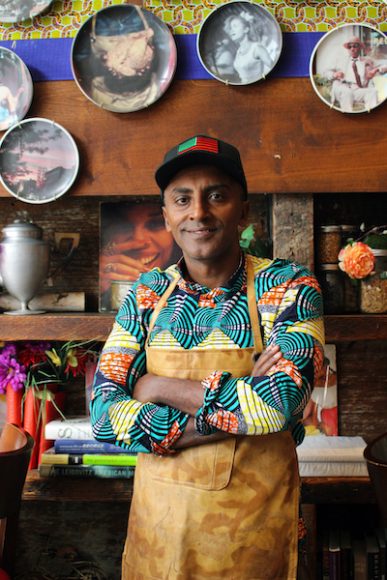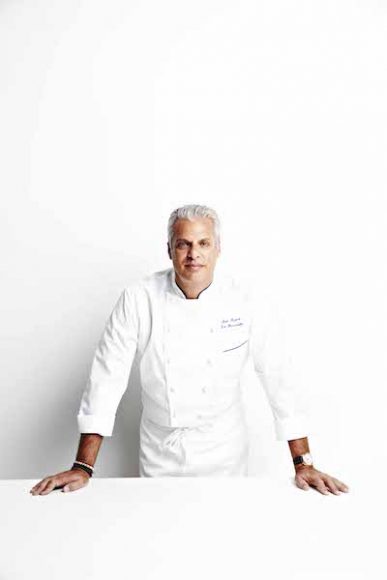The last time I saw Paris — oh, but let’s not get into all that schmaltzy stuff. France is off limits, so let’s just move on instead to Manhattan’s Le Bernardin, which, starting the beginning of November, will be reopening its doors to dinner guests, Tuesday to Saturday. Hurrah! Le Bernardin — with four New York Times stars held over four consecutive visits and three Michelin stars (the maximum) retained annually over 24 years — was New York City’s first non-Greek fish restaurant and, all these years later, it is still the most elegant, tony fish joint in town.
The menu changes subtly with the seasons but since the core component is fish — the fleshiest, glossiest, most sparkly eyed and freshly caught — perhaps only beady-eyed diners will catch the modifications. The cuisine here owes everything to skillful prep and aesthetic presentation and absolutely nothing to flashiness, fad or pointless reworking. Indeed, dishes at Le Bernardin, where the menu conveys the message in beguilingly minimalistic headings — “almost raw,” “barely touched,” “lightly cooked” — and where the most elaborate sauce, if that’s what the fish in question calls out for, might be no more than a drop of olive oil and a pinch of sea salt, show such respect for the product, elevate eating to such a degree, that — coupled with balletic service — you leave this restaurant walking on air.
On the prix fixe menu, you might find oysters, tuna tartare with sea urchin, wonderful Dover sole with a soy and lime emulsion, cuttlefish or pan-roasted monkfish with those wonderful Catalan noodles, called fideos. As if to emphasize Le Bernardin’s well-developed sense of noblesse oblige, there is even a filet mignon, should you or any one of your party dislike fish, for whatever reason. The wine list is a thing of beauty for any wine lover, with some welcome finds in the lower reaches. One thing is certain: No matter what you choose to eat or drink, you will not take a wrong step.
Perhaps, though, when all’s said and done, when the last petit-four has been joyfully popped into your mouth and the last drop of Sauternes has been drained, the most remarkable thing about Le Bernardin is Eric Ripert. Not in fact a Parisian but from Antibes in the South of France, along with co-owner and founder Maguy Le Coze, Ripert has, without ego, without tantrums, but simply with sheer, unadulterated class, worn the chef’s whites for the last quarter-century. As many will know, with his tanned, sculpted visage and shock of white hair, this man is also a veritable Adonis, but his inner beauty shines even brighter. A quiet philanthropist, Ripert is the chair of City Harvest, New York’s pioneering food rescue program, and he is always at the head of the line to help in any crisis — and goodness knows New York City has seen enough of them in recent years. No one has done more than this man to feed the hungry, sustain the first responders and speak up for the undernourished.
Another great chef to admire is Marcus Samuelsson, author of the new book “The Rise: Black Cooks and the Soul of American Food” (Voracious Books). From a small farming village without roads in Ethiopia, where he was born, to Sweden, where he was adopted and raised, to cooking at White House state dinners, he has never lost the common touch, not so much rising through the ranks as making ranks of his own, quashing boundaries, crossing continents, making light of obstacles, always putting others first. (See his PBS series, “No Passport Required.”) pbs.org/food/shows/no-passport-required/
At the start of the pandemic, Samuelsson turned his flagship Harlem restaurant, Red Rooster, into a community food hub, for locals in need. Now, happily, indoor dining has been restored, and the Rooster is currently serving dinner daily, with lunch or brunch Fridays through Sundays. The restaurant takes as its starting point the roots of American cuisine, reworks it, jazzes it up with culinary rhinestones and finally sends it boldly, brashly out onto the restaurant floor. A typical dinner here — not that dinner at the high-octane Red Rooster is ever typical — might be devilled eggs with crispy onions, bucatini pasta with crab, shrimp and lobster, or shrimp and grits with okra stew and chorizo. The YEP! Chicken & Waffle appetizer — much copied, never cloned — which I had on my last visit before lockdown, is a wonderful dish, comprising fried chicken smothered in maple hot sauce. It’s clucking brilliant.
Drinks, too, are worth more than a mention at Red Rooster, which offers a reasonably-priced wine list and clean, carefully-made cocktails, like the gin-based Juju Woman and the scotch-based Harlem Mule. Who, after all, doesn’t need a pick-me-up these days? (And the restaurant is only an eight-minute stroll from the Harlem-125th Street station, should you want to leave the wagon at home and ride Metro-North instead.)
It’s no mean feat to reopen your city restaurant in the time of Covid and, sadly, many of Red Rooster’s siblings, including its basement supper club, Ginny’s, along with outposts in London, Montreal (at the Four Seasons Hotel) and Bermuda, are currently closed. But with luck they will all reopen in time and the energetic, charismatic, indefatigable Samuelsson in the meantime seems as busy as ever. His philanthropic endeavors continue apace. Like Ripert, he works with City Harvest, while other charitable concerns include Food Bank for New York City and UNICEF. And, under the umbrella of Newark Working Kitchens, Samuelsson’s local B&P restaurant has helped deliver more than half a million meals to those in need in Newark, New Jersey.
Talk about giving back. These men wrote the book — one that eats as well as it reads.
For more, visit lebernardin.com and redroosterharlem.com.





